
Coastal wetlands
Coastal wetlands come in many forms and can be freshwater, brackish or saline. This page describes the features of different coastal wetland types.
Estuarine lakes and lagoons
A large open body of saline or brackish water which has a relatively narrow permanent or intermittent connection to the sea. Many coastal lakes and lagoons alternate between being open or closed to the ocean. These are known as Intermittently Closed and Open Lakes and Lagoons (ICOLLs). More about ICOLLs ...
Examples
- Myall Lakes
- Lake Macquarie
- Wooloweyah Lagoon (Clarence River system)
- St Georges Basin
- Burril Lake
Features
- Occur all along the NSW coast but are most extensive on the south coast. They are separated from the estuary or ocean by a barrier sand dune, and have a connection (usually intermittent) with the sea.
- The water can vary from brackish to as saline as sea water.
- Many coastal waterbodies are only open to the sea during floods or at very high tides. Due to the irregular connections with the sea they are usually characterised by changes in water levels.
- Lakes and lagoons that are more frequently open to the sea usually have submerged seagrass beds such as Zostera capricorni in the north or Zostera muelleri in the south.
- Less saline lagoons usually support species of sea tassel that often grows in association with stonewort.
- Shallow edges are usually dominated by emergent plants such as common reeds or sedges.
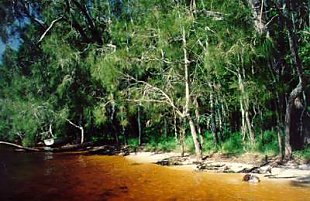
Myall Lakes. Photo: Dayle Green
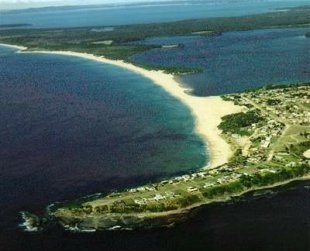
Wollumboola Lake. Photo: NSW DLWC
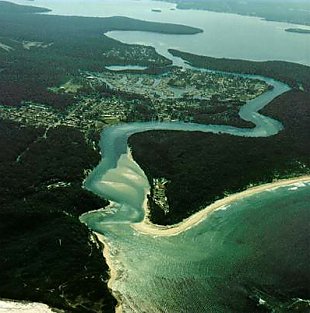
St Georges Basin. Photo: NSW DLWC
Mangrove and saltmarsh swamps
Examples
- Towra Point Nature Reserve, Botany Bay
- Eve Street Marsh (Cooks River floodplain)
- Kooragary Nature Reserve
- Coraki Broadwater
- Tweed River estuary
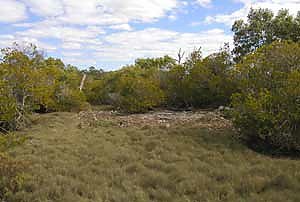
Typical mangrove and saltmarsh swamp. Photo: NSW DPIRD
Features
- Estuarine areas subject to tidal flooding which support mangrove and saltmarsh vegetation or non-tidal basins which occur on estuarine sediments adjacent to mangrove and saltmarsh areas, as well as any mudflats and small creeks which occur within or adjacent to the community
- Found along tidal shorelines which are exposed to seawater. They often extend up coastal rivers as far as the tidal limit.
- Mangrove and saltmarsh often occur in association with one another, with saltmarsh communities occurring on the landward side of mangroves.
- Dependant on periodic tidal inundation. In NSW, mangroves dominate those areas inundated daily, whereas saltmarsh vegetation occurs in areas less frequently flooded.
- Grey mangrove (Avicennia marina) is the dominant species within NSW and is present along the entire coastline.
- Within saltmarsh communities there is often a distinct zonation of vegetation across the wetland according to frequency of inundation from the sea. A typical zonation from sea to land is samphire, salt couch and salt rush. Swamp sheoak may be found growing in or on the landward margins of the marsh.

Mangrove wetland, Wongonga Inlet, Narooma. Photo: Trevor Daly
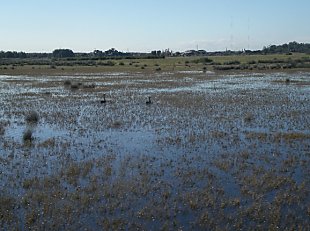
Hexham swamp, an example of a saltmarsh. Photo: Scott Machar.
Dune swamps and lagoons
Examples
- Lakes, lagoons, shallow vegetated basins, heaths and forests.
- Coomonderry Swamp, east of Nowra
- Lake Ainsworth, Lennox Head
Features
- Occur on coastal sand dunes or plains behind the present beach and foredune.
- Dependant on groundwater and runoff from local catchments.
- The waters of dunal lakes and swamps are often tea-coloured and acidic as a result of dissolved organic matter from peaty soils.
- Vegetation of dunal wetlands is distinctive although some species also occur on coastal floodplains. Seasonally flooded areas with a high watertable support a woodland or forest of broad-leaved paperbark. Paperbarks may also be found in swamps behind the foredune and sporadically around the perched swamps and lakes. Other vegetation typical of dune wetlands include sedges, rushes and wet heathland. The sedge species, Lepironia articulate, is common around the margins of perched lakes and may grow in water up to 6m deep.
Upland lakes and lagoons
- Large or small bodies of freshwater occurring usually in low hills or mountains.
Examples
- Lake George
- Thirlmere Lakes
- Lake Bathurst
Features
- Consist predominantly of open water, with vegetation, if present, confined to the margins of the wetland.
- Occur predominantly on the tablelands. On the tablelands of NSW upland lakes and lagoons occur in two main areas - the New England Plateau and the southern tablelands including the Monaro region. However any waterbody on the coastal or inland plains (apart from arid wetlands) which fills though a local catchment, groundwater or rainfall (i.e. is not flooded from a river) can be classed an upland lake.
- Upland waterbodies are found in depressions formed by erosion of the underlying bedrock, in depressions associated with past fault activity and in depressions scoured by past glacial activity.
- Water is sourced from groundwater, rainfall and/ or runoff from local catchments.
- Large internally draining lakes do not support much aquatic vegetation, although at times may have submerged growths of sea tassel, ribbonweed, Lepilaena spp. and water milfoils. Marginal vegetation is usually sparse and restricted to common reed, cumbungi, sedges and rushes. In the smaller lakes and lagoons of the New England and southern tablelands, tall spikerush is a common species in the more permanently inundated parts of the lake. A variety of species may be found growing around the less frequently inundated edges, including blown grass, knotweeds and water milfoil. Glacial lakes are generally devoid of any aquatic vegetation
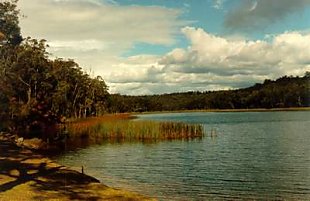
Thirlmere Lakes. Photo: Dayle Green
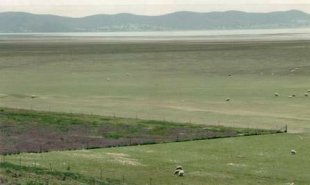
Lake George is typical of most of the large lakes which are perennial and subject to large reductions in area and depth during dry periods. Photo: NSW DLWC
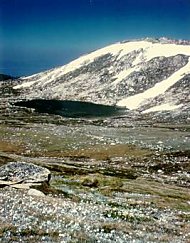
Blue Lake is a glacial lake. Glacial lakes are permanent as a result of high inflows from snowmelt and rainfall runoff combined with low evaporation. Photo: Dayle Green
Upland swamp
Vegetated freshwater wetlands including shallow marshes, sedge swamps, "hanging" swamps, wet heaths and peat swamps.
Examples
- Bega Swamp
- Wingecarribee Swamp
- Cathedral Rock National Park
Features
- Occur in shallow basins located in low hills or mountains, predominantly on or adjacent to the tablelands.
- Rely on groundwater, rainfall and runoff from a small local catchment for their source of water.
- May hold water permanently, or may fill on a seasonal or intermittent basis.
- Most tableland swamps have some degree of peat development.
- On the sandstone plateau's surrounding Sydney and the granite plateau of the New England area, "hanging swamps" of sedge and heath occur on valley sides. That is, where groundwater discharge occurs as a result of impermeable layers in the bedrock. Swamps may also occur on valley-fill deposits eroded from the surrounding ridges. In other parts of the tablelands, such as the Monaro region, swamps are found within shallow depressions formed through erosion of the underlying bedrock.
- The hanging swamps of the sandstone and granite plateaus are dominated by a mix of sedges, grasses and shrubs, generally with sedges occurring in the wettest areas. Sedge swamps tend to be dominated by members of the Cyperaceae family (commonly, razor sedge, button bog-rush, fringed cord-rush and slender yellow-eye). Common shrub species include teatrees, bottlebrush, hakea, banksia and melaleuca.
- Swamps with deep peat beds are typically restricted to acid fens and bogs. Acid fens occur where the water has a relatively higher mineral content and are dominated by sedges (usually Carex spp.).
- Where minerals are more deficient hummocks of sphagnum moss form valley bogs. The bogs are characterised by an uneven surface due to alternate hollows and hummocks of moss. The hummocks are formed above the water level by sphagnum moss or in less humid environments Blindia spp. or Bryum spp. The wet hollows in between contain a carpet of other mosses such as Polytrichum spp. and Breutelia spp.
Coastal floodplain forest
A wetland located on the floodplain of a coastal river which is dominated by trees.
Examples
- Yarrahappinni Wetland, Macleay River
- Tuckean Swamp, Richmond River
Features
- Occur on the sandy sediments located on the lower reaches of coastal floodplains.
- Rely on brief seasonal flooding from rivers as their main source of water.
- The dominant species of coastal floodplain forests is the broad-leaved paperbark. Forests of swamp she-oak typically occur along the lower reaches of coastal rivers and estuaries. Understorey species typically include rushes (Juncus spp.), Villarsia spp., common reed, water ribbon, Maundia triglochinoides and Persicaria strigosa and grasses (matgrass, spiney mudgrass, swamp rice grass and watercouch).
Coastal floodplain swamps and lagoons
This wetland type includes shallow marshes and meadows, as well as deeper ponds and billabongs which have large areas of open water.
Examples
- Belmore Swamp, Macleay River
- Everlasting Swamp, Clarence River
Features
- Located on the floodplain of a coastal river.
- They can form in a number of ways:
- Where the floodplain gradually slopes away from the river and abuts an adjacent terrace or hill on the edge of the floodplain (a "backswamp").
- As a ponded tributary where the river levee has dammed the junction of a smaller tributary.
- As a billabong resulting from the cut-off of a river bend.
- As a floodway or some other form of flood channel which is not connected to the river during normal flows.
- Rely on seasonal or intermittent flooding from a river as their main source of water. Local runoff contributes to the maintenance of some lagoons between floods while small ponds may fill after heavy rainfall.
- The vegetation in coastal swamps and lagoons is very dynamic and can change in response to seasonal fluctuations in water depth.
- Marginal species of coastal floodplain lagoons include jointed twig-rush, Lepidosperma spp., spikerushes, cumbungi, water ribbon and frogsmouth.
- Reasonably permanent lagoons may support submerged species such as ribbonweed, bladderwort, watermilfoil, and pondweed. Floating aquatic species include water primrose, swamp lily, waterlilies, duckweed and azolla.
- Coastal floodplain meadows which are continuously flooded over summer and autumn support a complex community including knotweeds, sedges and many emergent aquatic species.
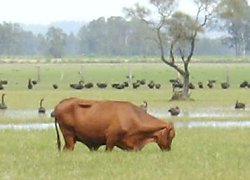
Cattle grazing a swamp in the Clarence River floodplain.
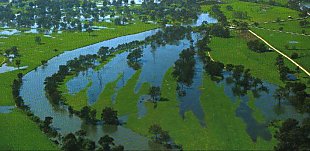
A typical floodplain swamp when flooded.

